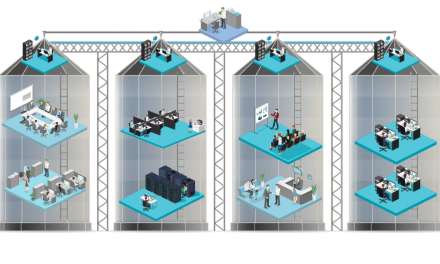“How long would it take me to become great under you?” he asks. “10 years,” the master swordsman replies.
“I don’t have that long,” says the student. “I want to be good soon. What if I worked very hard and dedicated myself completely to the task?”
“Ok, 30 years,” he says back.
“But that’s even longer,” the student says with some perplexity. “I am telling you I am in a hurry.”
And so the master replies, “Precisely, students in a hurry end up taking even longer to learn what is right in front of them.”
Short-term thinking dominates in management thinking. Sure, organizations define a strategy and longer-term goals, but goals-setting, results, and decision-making are often biased towards the short term. While it might seem appropriate for an adaptive organization to focus on the short term, after all, you want to react on what is coming, it can actually be a significant barrier to adaptiveness. There is a serious danger of sensing changes too late if there is too much focus on the short term.
This introductionary article is the first in a series of articles on short-term thinking as an adaptive anti-pattern. In this article we wille explore some examples you might recognise in your organization. In the follow-up articles we wille explore patterns derived from Systems Thinking that you can use to check if something simular is going on in your organization.
This article is part of a series
[series_post_list_box]
What can you expect from this article?
- An introduction in the danger of short-term thinking, especially as an adaptive anti-pattern
- Some recognizable examples of short-term thinking
- Follow-up articles will provide re-usable patterns derived from Systems Thinking that you can use to check if your organization falls into the same traps.
What’s the problem with short-term-thinking anyway?
Danger of sensing changes too late
The adaptive organization’s strategy is to be constantly on the lookout for new opportunities. It is hard for a company focusing on short-term results to find the patience and commitment needed to explore options whose potential value is unclear in the short term. But innovation is a long-term game. A 2016 Innosight executive briefing1 states: No business survives over the long-term without reinventing itself. The briefing continues: Leaders who define a vision for the future must follow it up with a commitment to invest in and manage long-term innovation and to build consensus for change among key stakeholders. That doesn’t mean there is no place for the short term. To the contrary: any new strategic opportunity under consideration is based on assumptions which need to be validated…fast.
Although most organizations will likely state they have a long-term vision with accompanying investment commitments, I dare to call this providing lip-service to the concept in most cases. Reality just proves otherwise. Innovation projects in most companies are very vulnerable to budget cuts or getting stopped altogether because of budget needs in support of the current dominant business model. This is even very understandable when the budget for innovation and the current business model are controlled by the same departments.
Bad behavior
Short-term thinking can lead to…well…bad behavior, that is not helping the organization meeting its purpose in the long run. We have all seen the examples: Short-term goals like quarterly sales targets lead to unwanted behavior just to meet the goals. An extreme example of this is the Wells Fargo Bank scandal: employees created fake accounts to boost their results under pressure of short-term targets. The Adaptive Organization is guided by a set of core values. A focus on short-term results, coupled with a focus on extrinsic motivation, aka rewards, will seriously undermine any attempt to let values be a guide to decision-making instead of a hierarchal structure.
A focus on the short-term can lead to bad behavior
Short-term success can lead to long term failure
Here’s an example from William Dettmer: The Rohr Corporation’s Riverside, California, plant recorded a 55 percent increase in profits in 1996. Great news, if all you focus on is short-term profits. When you look at the larger system, you see the reason for that increase is better “efficiency” (meaning cost cutting) temporarily had a greater impact than the 3 percent decline in sales. Or, as the corporate treasurer enthusiastically observed, “Costs have come down quicker than our revenue has decreased.” (I’m sure the 3,500 people laid off at Riverside by Rohr in the preceding few years are immensely gratified to know that!) 2
A short term focus often goes hand in hand with an obsessive focus on efficiency, which is the arch nemesis of continuous innovation. This might lead to short-term success which at the same time is the prelude to longer-term failure.
A prisoner of the short-term
Do you know the feeling that you seem to be so occupied with day-to-day operations and back-to-back meetings that you feel you’re always busy, but you are actually going nowhere? In a survey of executives from 91 companies with revenue greater than $1 billion across more than 20 industries, Innosight asked: “What is your organization’s biggest obstacle to transform in response to market change and disruption?” Forty percent of survey respondents blamed “day-to-day decisions” that essentially pay the bill, but undermine our stated strategy to change.”

Escape the tyranny of the urgent
We have a great follow-up article on this day-to-day decisions dilemma and how to set yourself free.
Conclusion
The Innosight executive briefing mentioned above also reports: Only 24% reported having a growth strategy with a time horizon of beyond five years. Now I feel the need to nuance this as we are not proponents of five-year strategic plans. In the complex environment organizations nowadays face, plans that are expected to be ‘just’ executed don’t work very well. You need to discover your future rather than plan it. We will replace the strategic plan with something else, as we will explore later. But it does show that many organizations don’t really look very far ahead.
In the remainder articles in this series on the short-term thinking adaptive anti-pattern we will explore some further phenomena we encounter in organizations about short-term thinking and the root causes of it.
These patterns, derived from Systems Thinking often provide surprising root cause insights why your organizations fall into the traps it does and how to get out.
Bibliography
List of notes and sources we reference from.
Notes
- Innosight. Corporate Longevity: Turbulence Ahead for Large Organizations. https://www.innosight.com/wp-content/uploads/2016/08/Corporate-Longevity-2016-Final.pdf
- Goal Systems International. Systems Thinking and the Cynefin Framework. H. William Dettmer. https://pdfs.semanticscholar.org/423c/c7df631b0a13b094e7362dbb0193157c93db.pdf]
- Innosight. Corporate Longevity: Turbulence Ahead for Large Organizations. https://www.innosight.com/wp-content/uploads/2016/08/Corporate-Longevity-2016-Final.pdf
Follow this article
You can choose to follow this article in which case you will be notified when there there are updates of the article. You can also choose to follow all articles of this category. You will then be notified if a new article is added in this category.






